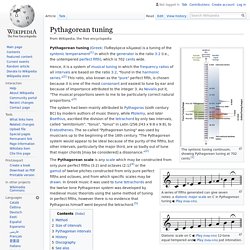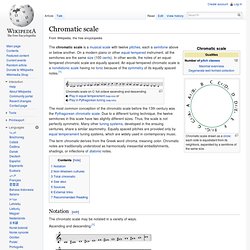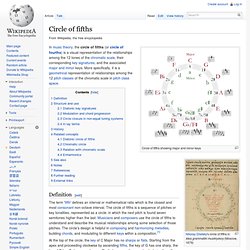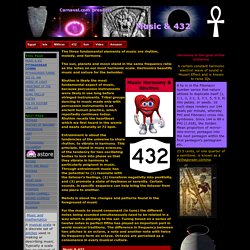

Partitions musicales gratuites. Pythagorean tuning. The syntonic tuning continuum, showing Pythagorean tuning at 702 cents.[1] Diatonic scale on C Play 12-tone equal tempered and Play just intonation.

Pythagorean (tonic) major chord on C Play (compare Play equal tempered and Play just). Comparison of equal-tempered (black) and Pythagorean (green) intervals showing the relationship between frequency ratio and the intervals' values, in cents. The system had been mainly attributed to Pythagoras (sixth century BC) by modern authors of music theory, while Ptolemy, and later Boethius, ascribed the division of the tetrachord by only two intervals, called "semitonium", "tonus", "tonus" in Latin (256:243 x 9:8 x 9:8), to Eratosthenes. Method[edit] Pythagorean tuning is based on a stack of intervals called perfect fifths, each tuned in the ratio 3:2, the next simplest ratio after 2:1.
This succession of eleven 3:2 intervals spans across a wide range of frequency (on a piano keyboard, it encompasses 77 keys). Size of intervals[edit] (e.g. between E♭ and E) Chromatic scale. Chromatic scale drawn as a circle: each note is equidistant from its neighbors, separated by a semitone of the same size.

The most common conception of the chromatic scale before the 13th century was the Pythagorean chromatic scale. Due to a different tuning technique, the twelve semitones in this scale have two slightly different sizes. Thus, the scale is not perfectly symmetric. Many other tuning systems, developed in the ensuing centuries, share a similar asymmetry. Equally spaced pitches are provided only by equal temperament tuning systems, which are widely used in contemporary music.
The term chromatic derives from the Greek word chroma, meaning color. Notation[edit] The chromatic scale may be notated in a variety of ways. Ascending and descending:[1] The chromatic scale has no set spelling agreed upon by all. Non-Western cultures[edit] Music, Fibonacci numbers and relationships to Phi. Musical scales are based on Fibonacci numbers The Fibonacci series appears in the foundation of aspects of art, beauty and life. Even music has a foundation in the series, as: Circle of fifths. Circle of fifths showing major and minor keys Nikolay Diletsky's circle of fifths in Idea grammatiki musikiyskoy (Moscow, 1679) In music theory, the circle of fifths (or circle of fourths) is a visual representation of the relationships among the 12 tones of the chromatic scale, their corresponding key signatures, and the associated major and minor keys.

More specifically, it is a geometrical representation of relationships among the 12 pitch classes of the chromatic scale in pitch class space. Definition[edit] L'art de jouer avec les ondes. La 432 Hz - Musique pour soigner les plantes - Music and Plants. Pythagorean tuning. Néomusic joue EVASION (432Hz) et expose quelques notions essentielles sur cette fréquence. Néomusic joue Evasion, une composition personnelle au synthétiseur, remasterisée en 432hz.

La fréquence 432 Hz est qualifiée par les scientifiques de « naturelle ». Ils ont calculé les fréquences de résonance des atomes et molécules dans la nature. L’oscillation à 432 Hz est une fréquence de résonance de l’eau. L’être humain étant composé de 70% d’eau (90% dans le cerveau), nous imaginons facilement l’influence que peut avoir ce diapason sur notre organisme!! Connaissance des gammes et modes musicaux. Un cours d'introduction pour débutants. Alain Boudet Dr en Sciences Physiques, Thérapeute psycho-corporel, Enseignant en éducation vocale Résumé: La gamme est un condensé de mélodie qu'on peut appréhender sans connaître le solfège, par l'approche sensorielle.

La gamme, c'est ce qui change sur les instruments à notes fixes lorsqu'on change la hauteur de la mélodie. La notion de mode est naturelle et reliée à la hauteur relative. Un mode, c'est ce qui reste fixe lorsqu'on change la hauteur de la mélodie. Contenu de la partie I Qu'est-ce qu'un mode? Je me posais ces questions tandis que j'étudiais le solfège dans mon adolescence. La notion de gamme nous est plus ou moins familière, car nous en entendons parler par ceux qui suivent des études musicales instrumentales, à moins que ce soit nous-mêmes qui les suivions, et nous devons passer par la répétition fastidieuse des gammes, Do majeur, La mineur, etc.
432: Sacred Music of the Spheres. The Schumann resonance (SR) is a set of spectrum peaks in the extremely low frequency (ELF) portion of the Earth's electromagnetic field spectrum.

Schumann resonances are global electromagnetic resonances, excited by lightning discharges in the cavity formed by the Earth surface and the ionosphere. Lightning discharges are considered as the primary natural source of Schumann resonances. Lightning channels behave like a huge antenna which radiates electromagnetic energy as impulsive signals at frequencies below about 100 kHz [15]. These signals are very weak, but the earth-ionosphere waveguide behaves like a resonator at ELF frequencies and amplifies the spectral signals from lightning at the resonance frequencies [15]. In an ideal cavity, the resonant frequency of the n-th mode fn is determined by the Earth radius a and the speed of light c [6].
In physics, resonance is the tendency of a system to oscillate at maximum amplitude at a certain frequency.